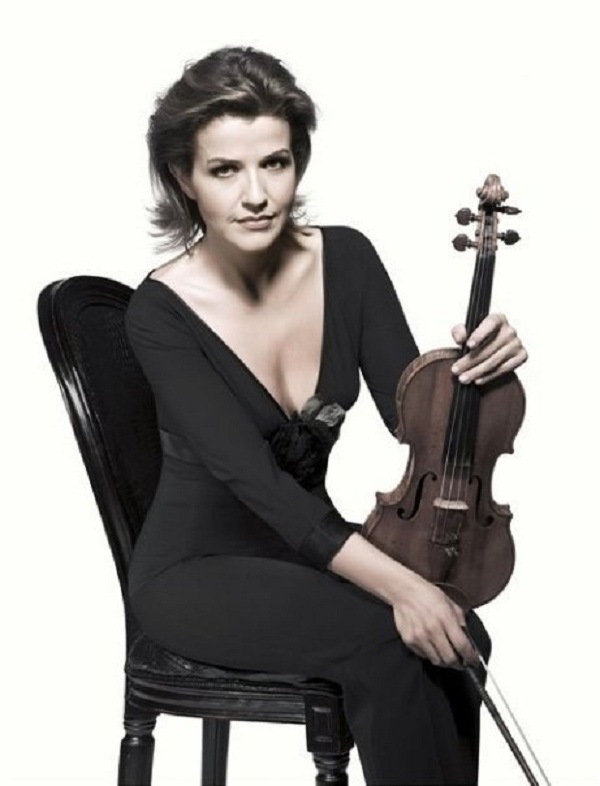A new Penderecki masterwork unveiled in Mutter’s rewarding recital

Anne-Sophie Mutter premiered two new works by Krzysztof Penderecki and Andre Previn Saturday night at Carnegie Hall
It has been twenty-five years since Anne-Sophie Mutter made her Carnegie Hall debut, and in that time the German violinist has shown a commitment to expanding the violin repertoire. She renewed that commitment on Saturday night when she returned to Carnegie with the pianist Lambert Orkis in a two-and-a-half hour recital that featured two world premieres, including one that seems likely to stick around for a very long time.
They set the tone for the recital with a searing performance of Witold Lutoslawski’s Partita for Violin and Piano (1984). Mutter is usually known for hot-blooded romanticism, but here her playing was bare, allowing the intelligence of the piece to speak for itself. She vividly captured the first movement’s wide range of character, from the vindictive and merciless to the mournful and pleading. Orkis matched her with sensitivity and color.
She painted with broad strokes in the Largo, bringing in a thick molasses tone. She didn’t shy away from harshness where it was required, occasionally sounding gutty and rough on the low strings, and shrill up top. She ranged dolefully through the second Ad libitum, and for a moment was answered by the wail of a police siren from outside the hall.
The presto sections of the last movement were relentless, and the lulls in between offered little solace. Instead, they seemed to magnify the movement’s sense of grief as Mutter wandered through the searching, lyrical unease.
The pair seemed of two minds about Schubert’s Fantasie in C Major. Orkis was light, crisp, and sparkling at the piano, while Mutter dug in her heels. Either of these would have made for a valid interpretation, but there was no agreement between the two of them as to how they wanted to read the piece.
Mutter’s tone was fabulously warm in the first movement, though she was missing that wistful, slightly bitter, Schubertian nostalgia. There was no sense of ease in playing, but instead a rough intensity that felt out of place. The difference between the two players was most evident in the middle movements, where Mutter was deadly serious while Orkis played with sparkling wit.
The allegro vivace section of the finale was bright and shining, though Mutter’s vibrato was extremely wide, making it feel less tight. She played the bariolage of the closing Presto with tremendous gusto, and got just a little too crunchy as she raced to the finish.
Mutter ended the half with the first of the two premieres, Krzysztof Penderecki’s La Follia (2013) for solo violin. According to the program notes, Penderecki originally called the piece a chaconne, but was spooked by potential comparisons to the great finale of Bach’s D-minor Partita. He needn’t have worried—La Follia is a remarkable work in its own right.
A more apt comparison would be the solo sonatas of Eugène Ysaÿe. La Follia requires dazzling virtuosity from the performer, but a mere showpiece it is not. Penderecki’s La Follia is a rich, complex, and intensely poetic work. The initially plodding descending theme is fleshed out in a series of nine variations that are at times darkly ruminative and at times furious, but constantly unsettling in their claustrophobic chromaticism.
Mutter played with arresting poise and sensitivity. Himself a violinist, Penderecki has written a piece that explores the deepest reaches of the violin’s natural voice (his use of extended technique here is judicious) and will surely prove an eminently worthy addition to the instrument’s solo repertoire.
What followed made the recital seem top-heavy. André Previn’s Sonata No. 2 for Violin and Piano (2012), the other premiere, was enjoyable, but suffered from direct comparison to the Penderecki work, not offering as much in the way of emotional depth and artistic challenge.
The first movement, “Joyous,” was just that—bright and pleasant, it seemed to skip by in an instant. Only the opening of the second movement, “Desolate,” felt in touch with its title. There was a sense of aimlessness throughout, but real emptiness there was not, especially with Orkis plowing through the faster sections. The finale, “Brilliant, quasi cadenza” was a rowdy, bouncy, silly affair—a delightful ending, though not so free as its title suggests.
Saint-Saëns’s Violin Sonata No. 1 also came off as lighter fare compared to the first half, but it got a solid performance on Saturday. The opening of the first movement is intense, yet earnest, and Mutter played it with passion. She lost herself slightly at one point, but wasn’t at all rattled, jumping back in with ferocity. The Adagio section got a touch swoony, but she caressed it with a rich, velvet tone.
The pair tripped and danced through a lively and playful Allegro moderato, but couldn’t agree on the Allegro molto finale, in which Mutter ran away from her partner. She fell into a trap that is all too familiar, even to the most mature and accomplished of musicians: She picked a tempo faster than was comfortable, and rushed frantically through the presto sections towards the lulls, despite Orkis’s attempts to rein her in. The sense of constantly skittering along the edge kept her from really unleashing her fire.
The first of two encores, Brahms’s Hungarian Dance No. 1, defined “schmaltz.” Heavy on portamento, replete with rubato, and entirely over-the-top, it was impossible not to grin at. Kreisler’s beloved transcription of Dvorak’s Humoresque followed. It too was unabashedly romantic, even sitting a hair on the south side of true pitch—a little jazzier than usual, but exceptionally charming.



Posted Dec 16, 2013 at 5:25 pm by Magdalena Golczewski
As a professional violinist I join with my husband a composer/conductor in congratulating you on an insightful, learned and detailed review. We were there and both of us
admire her artistry. The only thing missing in your superb review was mention of the faint rumbling of the subway…..